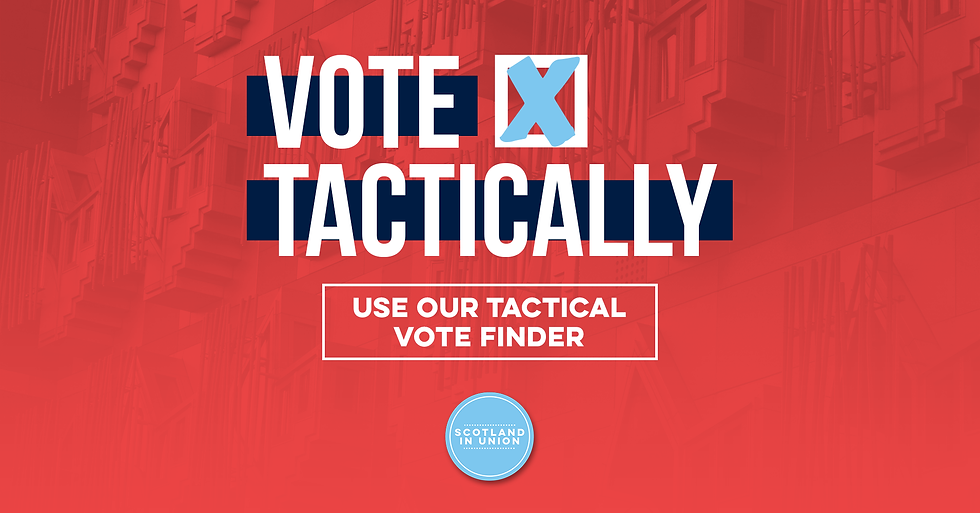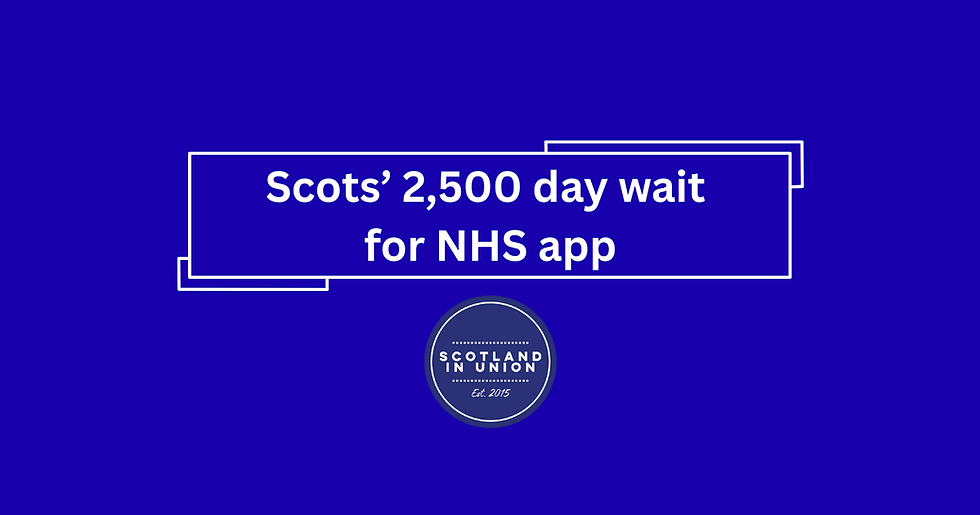It's simple - Voting for fringe pro-UK parties helps the SNP
- Scotland in Union

- Apr 4, 2021
- 5 min read
Many of our supporters and members of the public have contacted Scotland in Union to ask who they should vote for to stop a nationalist majority being elected at the Scottish Parliament elections in May. This is why we have launched our Tactical Voting Guide where you can pop your postcode in and check who we are suggesting to vote for in your area.
Our voting advice focuses on the party which has the best chance to stop the SNP in each constituency, and suggests that voters back their favourite established pro-UK party in the regional party list vote - Labour, the Tories or the LibDems. We do not support splitting the pro-UK vote by supporting any other smaller party, which would only help the SNP. We thought we would explain this a little further.
Not all votes for pro-UK parties will have the same impact on the final results because of the way the electoral system for the Scottish Parliament works. In particular, the mechanics of Scottish elections mean that voting for a fringe pro-UK party is a sure-fire way to reduce the total number of pro-UK MSPs elected, and indirectly assist the SNP.
Conversely, these same complexities mean that Alex Salmond’s new Alba party could either be a help or a hindrance to the pro-independence cause, depending on the precise share, distribution, and source of Alba votes.
Each voter in Scotland gets two votes in May: a constituency vote and a list vote.
The constituency vote works just like a vote in a UK-wide general election. After polls close, the constituency votes are tallied up in each of Scotland’s seventy-three Scottish Parliament constituencies, and the party with the most votes in each constituency wins a seat.
Since the pro-UK vote is split between a number of major parties and the overwhelming majority of the nationalist vote has historically gone to the SNP, the SNP has tended to win most of its seats via the constituency vote. Thus, the best way to stop the SNP using your constituency vote is to make sure to vote for whichever is likely to be the largest pro-UK party is in your constituency, whether it is Labour, the Conservatives, or the Liberal Democrats.
The second vote that voters in Scotland cast is the regional list vote, which is a more complicated process. The list vote assigns fifty-six further MSPs through a roughly proportional formula called the d’Hondt system, designed to allocate additional seats to parties that performed well on list votes, but did not win many constituencies.
For the d’Hondt system, Scotland is divided into eight regions, such as Glasgow, Highlands and Islands, or Mid-Scotland and Fife, and each region is given a set of seven list MSP seats to allocate.
First, the number of list votes that each party receives in each region is tallied up. This number is then divided by the number of constituencies that the party won in the region plus one, to give a ‘score’ to each party. The party with the highest score is assigned one MSP.
Next, the same calculation is repeated, but this time the list vote divisor is increased by one for the party that just received a MSP, reducing their score to account for the fact that they’ve already been assigned a MSP. This process is then continued until all the MSPs for that region have been assigned.
Still with us?!
In theory, the list vote is designed to make the final assignment of MSPs more proportional to the overall preference of Scottish voters. If a party wins many votes, but does not come first in many individual constituencies, they will gain MSPs through the list vote. On the other hand, if a party wins more constituencies than their raw vote share would suggest, they will gain very few list MSPs, diluting their overall representation.
In recent elections, pro-UK parties have won most of their MSPs through list votes. In 2016, the Conservatives won seven constituencies and twenty-four list seats, and Labour won just three constituencies, but twenty-one list seats.
During the 2021 elections, though, new parties have sprung up to try to exploit a vulnerability in the list vote system that could break the proportionality of Scottish elections.
Under the Scottish d’Hondt system, parties that have already won constituency seats are penalised in assigning list MSPs. But these new parties are not campaigning for constituency seats at all.
Alba is especially brazen about this strategy, labelling their goal an “independence supermajority”: capitalising on this loophole to elect far more pro-independence MSPs than would be proportional to the share of Scottish voters supporting independence.
But in practice, while this strategy has some chance of success on the nationalist side, it will almost certainly backfire on the pro-UK side.
The pro-independence side is simply not very reliant on list votes. The SNP only won four list seats in 2016, while the Scottish Greens won six, giving a total of ten pro-independence list MSPs. In contrast, forty-six pro-UK MSPs were elected through the list, the bulk of the pro-UK Holyrood delegation. The cost of "wasted" list votes is much higher for the pro-UK side.
Modelling of the Scottish electoral system suggests that if the share of pro-UK voters supporting minor parties instead of the established parties doubles, the SNP could hang on to a majority of MSPs with as little as 34% of list votes, three full percentage points lower than if all pro-UK voters voted for one of the big three.
To be clear, voting for a smaller, fringe pro-UK party rather than Labour, the Liberal Democrats or the Conservatives will divide the pro-UK vote further and make it easier for the SNP to win seats and achieve a majority.
You can see what happens in more detail in the graph below. The grey line represents the number of Holyrood seats that nationalists would win based on the SNP share of list votes, assuming that pro-UK voters split their votes between parties along the lines that current polling suggests. The red line shows what would happen if the SNP vote didn’t change, but the share of pro-UK voters voting for minor rather than major parties with their list votes doubled.
Tactical allocation of pro-UK list votes may determine Holyrood control

The red line is consistently higher than the grey line, meaning that any SNP vote number translates into more nationalist MSPs when the pro-UK vote is more divided among smaller parties. The green line shows what would happen if every pro-UK voter voted for one of the three main pro-UK parties: however many votes the SNP gets, that translates into fewer nationalist MSPs.
In a close election when Scotland’s future in the UK may sit in the balance, these votes could make the difference between five more years of the SNP, or a pro-UK majority that guarantees Scotland’s secure future in the UK.










Comments